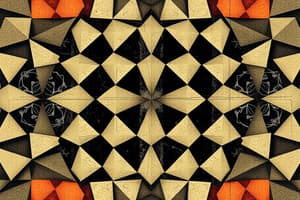Podcast
Questions and Answers
Which type of symmetry is exhibited by a butterfly?
Which type of symmetry is exhibited by a butterfly?
- Rotational Symmetry
- Translational Symmetry
- Bilateral Symmetry (correct)
- Radial Symmetry
What is the next number in the arithmetic sequence: 5, 10, 15, 20?
What is the next number in the arithmetic sequence: 5, 10, 15, 20?
- 25 (correct)
- 35
- 30
- 20
If an object has rotational symmetry about a point, what can be concluded?
If an object has rotational symmetry about a point, what can be concluded?
- It appears unchanged after certain rotations. (correct)
- It shows reflectional symmetry.
- It has no symmetry.
- It can be divided into two identical halves.
Which of the following represents a geometric sequence?
Which of the following represents a geometric sequence?
What type of symmetry does a snowflake typically demonstrate?
What type of symmetry does a snowflake typically demonstrate?
Which pattern is an example of a Fibonacci sequence?
Which pattern is an example of a Fibonacci sequence?
What is a key characteristic of translational symmetry?
What is a key characteristic of translational symmetry?
In which of the following scenarios would reflectional symmetry apply?
In which of the following scenarios would reflectional symmetry apply?
Recognizing patterns is crucial for what aspect of mathematics?
Recognizing patterns is crucial for what aspect of mathematics?
Flashcards
Mathematical Patterns
Mathematical Patterns
Recurring sequences of numbers, shapes, or symbols following specific rules.
Arithmetic Sequence
Arithmetic Sequence
A pattern where each term is obtained by adding a constant to the previous term.
Geometric Sequence
Geometric Sequence
A pattern where each term is obtained by multiplying the previous term by a constant.
Fibonacci Sequence
Fibonacci Sequence
Signup and view all the flashcards
Symmetry
Symmetry
Signup and view all the flashcards
Rotational Symmetry
Rotational Symmetry
Signup and view all the flashcards
Reflectional Symmetry
Reflectional Symmetry
Signup and view all the flashcards
Translational Symmetry
Translational Symmetry
Signup and view all the flashcards
Bilateral Symmetry
Bilateral Symmetry
Signup and view all the flashcards
Radial Symmetry
Radial Symmetry
Signup and view all the flashcards
Study Notes
Patterns in Mathematics
- Patterns in mathematics are recurring sequences of numbers, shapes, or symbols following a specific rule or formula.
- Recognizing patterns is crucial for problem-solving, enabling prediction of future elements and generalization of relationships.
- Patterns can be visual (geometric shapes), numerical (sequences), or algebraic (equations).
- Examples include arithmetic sequences (e.g., 2, 4, 6, 8), geometric sequences (e.g., 2, 4, 8, 16), and Fibonacci sequences (e.g., 1, 1, 2, 3, 5).
Symmetry in Mathematics
- Symmetry describes a shape or object's property of remaining unchanged after transformations (rotations, reflections, translations).
- Symmetry types include:
- Rotational Symmetry: An object looks the same after rotation around a point by a specific angle.
- Reflectional (Line) Symmetry: A line divides an object into mirror-image halves.
- Translational Symmetry: A repeating pattern along or across a plane.
- Symmetry is vital in art, architecture, and engineering, improving aesthetics and structural stability.
- Symmetry helps understand relationships and properties in shapes and objects.
- Symmetry types include:
- Bilateral Symmetry: Divisible into two identical halves by one line (like a butterfly).
- Radial Symmetry: Divisible into multiple identical halves by multiple lines from a center (like a starfish).
- Symmetry is essential in many geometric figures and shapes.
- Examples include snowflakes, butterflies, and flowers.
Relationships Between Patterns and Symmetry
- Patterns often exhibit symmetry, and symmetry frequently arises from patterns.
- For instance, repeating patterns can show rotational or reflectional symmetry.
- Combining pattern and symmetry analysis deepens understanding of mathematical properties and structures.
- This combined approach improves problem-solving and comprehension of mathematical structures.
Studying That Suits You
Use AI to generate personalized quizzes and flashcards to suit your learning preferences.




